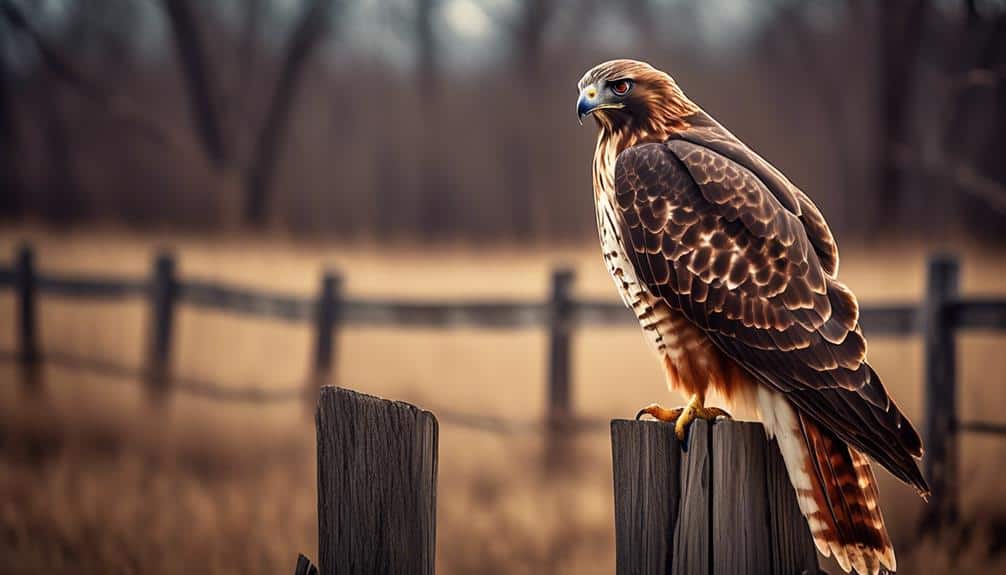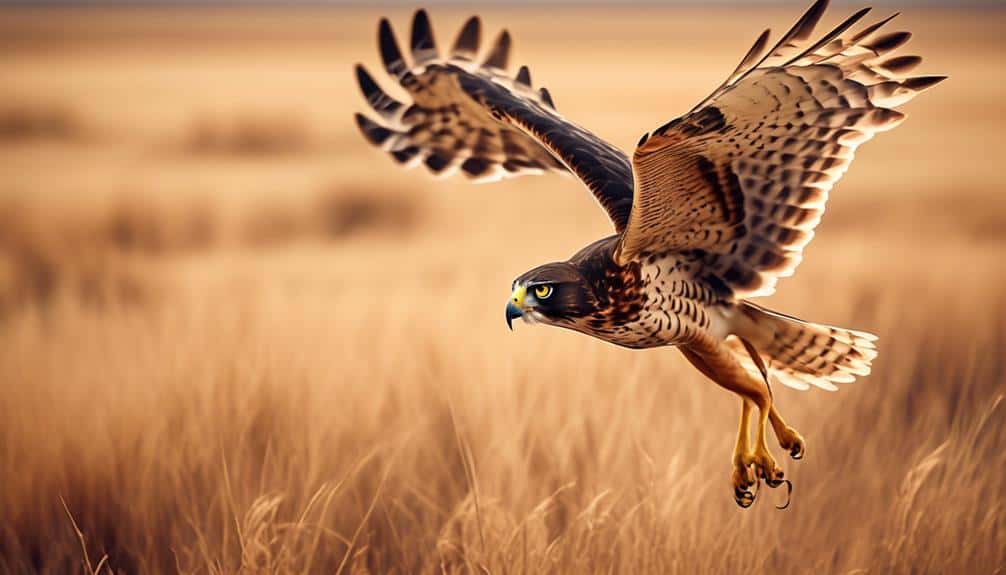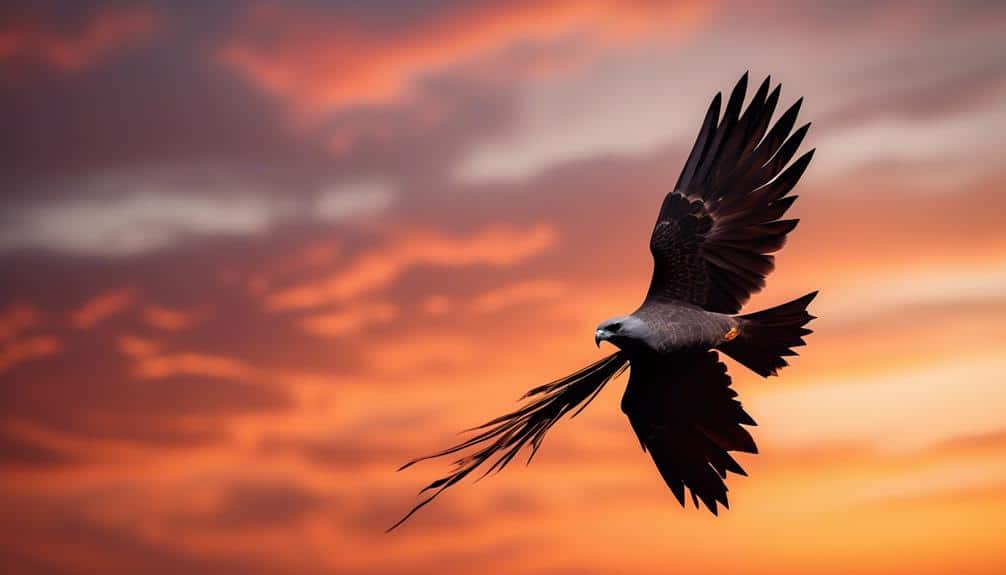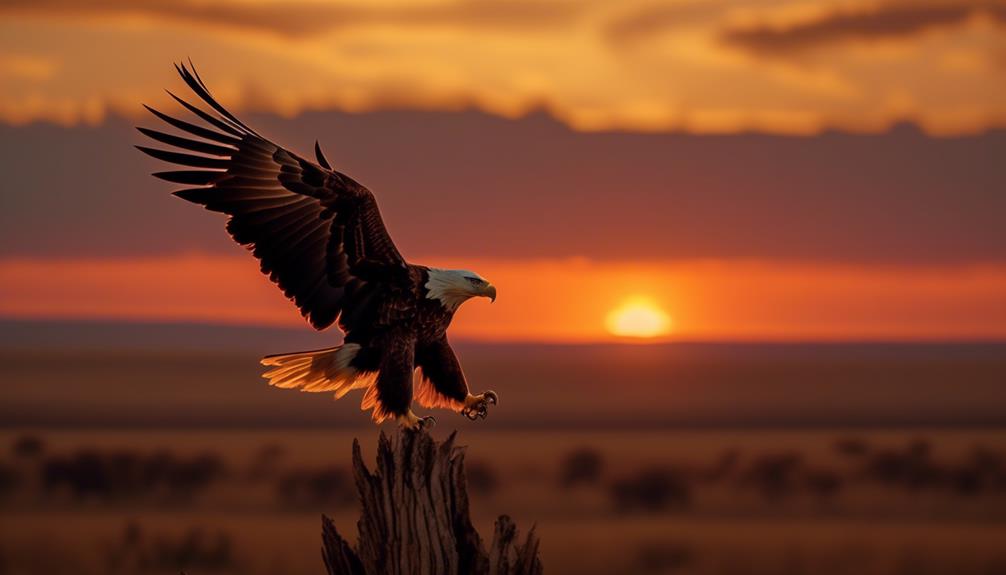Growing up in Oklahoma, I always found myself intrigued by the majestic birds of prey that call this state home. From the bald eagle soaring high above, reminding us of our nation's freedom, to the silent hunting techniques of the great horned owl, these creatures have captivated my imagination.
But it doesn't stop there. Oklahoma is also home to the colorful American kestrel, the common predator known as the red-tailed hawk, the master of flight, the northern harrier, and the migratory marvel, the Mississippi kite. Each bird has its own unique characteristics and adaptations that make them truly remarkable.
So, let's take a closer look at these fascinating birds and uncover the secrets they hold in the skies of Oklahoma.
Bald Eagle: The Symbol of Freedom

The Bald Eagle, a majestic and powerful bird of prey, is revered as the symbol of freedom in the United States. This iconic species represents the ideals of strength, courage, and independence. Beyond its symbolic significance, the conservation of the bald eagle is of utmost importance.
Bald eagle conservation efforts have been instrumental in ensuring the survival of this magnificent species. Due to habitat loss, pollution, and hunting, the bald eagle population dramatically declined in the past. In response, comprehensive conservation measures were implemented, including the ban on DDT, a pesticide that caused thinning of their eggshells. These efforts, coupled with habitat protection and captive breeding programs, have led to a remarkable recovery of the bald eagle population.
The symbolism of the bald eagle goes beyond its physical attributes. Its stoic nature and powerful flight embody the spirit of freedom cherished by the American people. With its keen eyesight and soaring flight, the bald eagle represents the ability to rise above challenges and achieve greatness.
The bald eagle's conservation success story serves as a reminder of our responsibility to protect and preserve the natural world. By ensuring the continued existence of this magnificent bird, we're safeguarding not only a national symbol but also the integrity of our ecosystems. It's through our commitment to conservation that we can guarantee the freedom and abundance of our natural heritage for future generations.
Great Horned Owl: The Silent Hunter

After exploring the significance of the bald eagle as a symbol of freedom, it's now time to turn our attention to another formidable bird of prey: the Great Horned Owl, a masterful silent hunter. This majestic creature possesses a range of adaptations and hunting techniques that make it one of nature's most efficient predators.
- Silent Flight: The Great Horned Owl possesses specialized feathers with serrated edges that enable it to fly silently through the night sky. This adaptation allows the owl to sneak up on its prey undetected, ensuring a successful hunt.
- Keen Eyesight: With large, forward-facing eyes, the Great Horned Owl has exceptional vision, particularly in low light conditions. Its eyes are well adapted for night hunting, and they provide the owl with the ability to spot even the smallest movements of its prey from great distances.
- Powerful Talons: The Great Horned Owl's talons are its most formidable weapon. With razor-sharp claws and a crushing grip, these talons allow the owl to capture and kill prey quickly and efficiently. The owl's strong feet and talons enable it to take down prey larger than itself, including rabbits, skunks, and even other birds of prey.
American Kestrel: The Colorful Falcon

In the realm of vibrant avian predators, the American Kestrel stands out as a truly captivating and colorful falcon. With its striking plumage and distinctive hunting techniques, this species is a fascinating addition to Oklahoma's bird population.
The American Kestrel is known for its breeding behavior, which involves intricate courtship displays and the formation of monogamous pairs. During courtship, the male performs acrobatic flight displays, showcasing its agility and strength to attract a mate. Once paired, the male and female work together to build a nest in tree cavities or man-made structures.
In terms of diet and feeding habits, the American Kestrel is a versatile hunter. It primarily feeds on small mammals such as voles, mice, and shrews, but it also preys on insects, reptiles, and other birds. This falcon is known for its ability to hover in mid-air, scanning the ground for potential prey. Once it spots its target, the American Kestrel will swoop down with incredible speed and accuracy, using its sharp talons to grasp its prey. Its keen eyesight and agile flight make it a formidable predator in Oklahoma's ecosystem.
Red-tailed Hawk: The Common Predator

How does the Red-tailed Hawk contribute to Oklahoma's ecosystem as a common predator?
The Red-tailed Hawk, scientifically known as Buteo jamaicensis, is a formidable and widely distributed raptor in Oklahoma. It plays a crucial role in maintaining the balance of the ecosystem as a common predator.
Here are three ways in which the Red-tailed Hawk impacts its environment:
- Hunting Techniques: The Red-tailed Hawk is a skilled hunter, employing various techniques to capture its prey. It primarily hunts by soaring at great heights, surveying the landscape for potential targets. Once a prey is spotted, it swoops down with astonishing speed, using its sharp talons to seize and immobilize it. Its hunting repertoire includes hunting from perches, cooperative hunting, and even scavenging carrion.
- Habitat Preferences: The Red-tailed Hawk exhibits a wide range of habitat preferences, making it adaptable to various environments across Oklahoma. It can be found in diverse landscapes, including grasslands, forests, and agricultural areas. This adaptability allows the Red-tailed Hawk to exploit different food sources, ensuring a stable population and effective predator-prey dynamics.
- Ecological Balance: As a top predator, the Red-tailed Hawk helps regulate populations of its prey species. By preying on small mammals, birds, reptiles, and even amphibians, it helps control their numbers, preventing overpopulation and the subsequent negative impacts on vegetation and other animal communities. Its presence in Oklahoma's ecosystem promotes biodiversity and maintains a healthy ecological balance.
Northern Harrier: The Master of Flight

The Northern Harrier, known scientifically as Circus hudsonius, showcases unparalleled mastery of flight in Oklahoma's bird of prey community. This aerial acrobat is truly a sight to behold, with its unique hunting techniques and habitat preferences.
The northern harrier has distinct features that set it apart from other birds of prey. With a wingspan of 40 to 48 inches, it has long, narrow wings that allow it to glide effortlessly through the air. Its body is slim and elongated, with a long tail that helps with maneuverability during flight. The harrier's facial disk, similar to that of an owl, aids in sound localization and allows it to detect prey even in low light conditions.
When it comes to hunting, the northern harrier is a master strategist. It employs a technique known as 'quartering' – flying low over open grasslands, marshes, and fields, searching for small mammals, birds, and reptiles. Its keen eyesight and acute hearing enable it to locate prey from a distance. Once a target is spotted, the harrier swoops down with incredible speed and agility, using its sharp talons to capture the unsuspecting victim.
In terms of habitat preferences, the northern harrier favors open areas such as grasslands, marshes, and agricultural fields. These habitats provide the ideal hunting grounds for this bird of prey, as they offer a plentiful supply of small mammals and birds.
Mississippi Kite: The Migratory Marvel

With its impressive migratory patterns and graceful aerial maneuvers, the Mississippi Kite captivates bird enthusiasts across Oklahoma. This medium-sized raptor, named after the Mississippi River, is known for its stunning migration patterns and unique breeding habits.
Here are three fascinating facts about the Mississippi Kite:
- Migratory Marvel: Each year, Mississippi Kites embark on an extraordinary journey, traveling thousands of miles from their breeding grounds in Oklahoma to their wintering grounds in Central and South America. These skilled fliers navigate vast distances, relying on thermals and wind patterns to aid their journey. It's awe-inspiring to witness flocks of Mississippi Kites soaring effortlessly through the sky as they make their way to their winter homes.
- Breeding Habits: Mississippi Kites are monogamous birds that mate for life. They construct nests high up in trees, often near water sources, using twigs, leaves, and grass. The female lays one to three eggs, and both parents take turns incubating them for about a month. Once the chicks hatch, the parents tirelessly feed and care for them until they fledge and become independent.
- Cooperative Behavior: During the breeding season, Mississippi Kites are known to exhibit cooperative breeding behavior. This means that young kites from previous years often stay with their parents to help raise the next generation of chicks. This cooperative effort ensures the survival and success of the offspring and strengthens the social bonds within the kite community.
The Mississippi Kite's remarkable migratory patterns and unique breeding habits make it a true marvel of nature. Its ability to traverse long distances and its cooperative behavior during the breeding season demonstrate the intelligence and adaptability of this captivating bird.
Frequently Asked Questions
What Is the Lifespan of a Bald Eagle?
The lifespan of a bald eagle is typically around 20 years in the wild, although some have been known to live up to 30 years. Their behavior includes nesting, hunting, and soaring through the sky.
How Does the Great Horned Owl Hunt Its Prey?
How does the great horned owl hunt its prey? With silent wings, razor-sharp talons, and incredible vision, this majestic predator swoops down from the treetops, selecting its prey with precision and skill.
What Is the Average Wingspan of an American Kestrel?
The average wingspan of an American kestrel is around 20 inches. This small falcon possesses a unique ability to hover in mid-air while hunting for its prey, making it a fascinating bird to study.
How Does the Red-Tailed Hawk Build Its Nest?
The red-tailed hawk constructs its nest using a variety of nesting materials. It carefully weaves sticks and twigs together to create a sturdy foundation, then lines the nest with softer materials like grasses and feathers.
What Is the Migratory Pattern of the Mississippi Kite?
The Mississippi kite exhibits interesting migratory behavior and distinct breeding habits. It travels annually between North and South America, following the changing seasons. During breeding season, it forms monogamous pairs and builds nests in tree canopies.
Conclusion
As I conclude this exploration of the birds of prey in Oklahoma, I'm in awe of their magnificent presence and diverse capabilities.
From the soaring Bald Eagle, the symbol of freedom, to the silent hunter, the Great Horned Owl, these majestic creatures captivate our senses.
With their vibrant colors and swift flight, the American Kestrel stands out in the sky, while the Red-tailed Hawk remains a common predator.
Lastly, the Northern Harrier and Mississippi Kite showcase their mastery of flight, leaving us marveling at their migratory journeys.
Truly, Oklahoma is a haven for these remarkable birds of prey.






